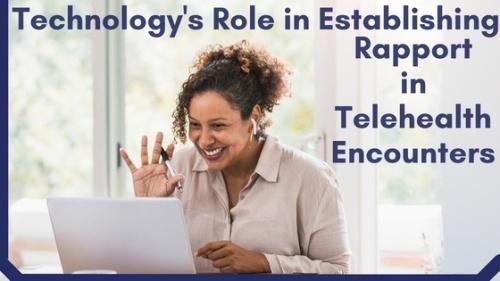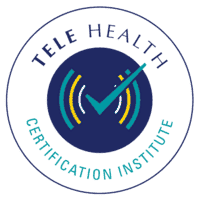There are many factors that contribute to the success of a telehealth encounter, as there are many factors that contribute to the success of an in-person encounter. Ideally technology should not represent a barrier or challenge to conducting a successful telehealth visit, especially in terms of establishing a feeling of rapport between patient and provider. Technology is just the means to accomplish an end – providing effective and efficient healthcare to patients. The expectation that it is the same as in-person is misplaced as the expectation really is that it should be equivalent. It cannot be denied that the use of technology as a means of communication fundamentally changes the nature of an encounter. This change however should not be regarded as negative – there are actually some people who communicate better virtually than in person and vice versa. The differences between in-person and virtual encounters need to be acknowledged and participants need to be aware of these differences and learn how to adjust their actions and communication styles to accommodate the differences.
To help in this regard, the field of human factors can provide some very useful information. The field of human factors examines the social, psychological, biological, and physical components that inform the design, development & operation of products or systems. The goal is to optimize performance, user safety, satisfaction with ultimate goal maximizing benefits user experience. When considering human factors and rapport in telemedicine, there are four important dyads involved: clinician-consultant, consultant-patient, consultant-facilitator, and human-machine. All of these impact rapport in both in-person and virtual encounters when you consider providers interact with the electronic health record in both cases, plus a variety of digital technologies that acquire health data.
Consider our senses – how important they are in a clinical encounter and how they differ for in-person and virtual and establishing rapport. Touch can be healing or therapeutic with a simple gesture like a handshake, pat on back, or hug, but (at least for now) feasible only during an in-person encounter. Vision is critical to assess a multitude of signs and symptoms and is perhaps the very foundation for establishing rapport through the simple act of looking at each other and making eye contact. Visual cues are available in both types of encounters, and in both situations, there can be limitations. For example, providers and patients can have visual impairments that impact both situations (possibly exacerbated virtually), but virtual encounters typically limit the scope or field of view (i.e., in most cases, participants only see the other’s head and shoulders), making it difficult for providers to detect things like subtle movements (e.g., hand tremors) and facial expressions. The situation is very similar for hearing - providers and patients can have auditory impairments that impact both situations (possibly exacerbated virtually), but virtual encounters typically limit one's ability to detect subtle voice characteristics (e.g., voice tremors) that can be important for diagnoses or just communicating. Both vision and audition are negatively impacted by poor technology connections, reducing rapport. One may not think that smell is important, but in person, a provider can smell alcohol on a patient’s breath, marijuana on their clothes, or whether they have showered or not recently – all useful cues about a patient’s health status but not available virtually. Taste – OK, maybe nothing useful here for either modality. Finally, however, is our sixth sense. There are times when a patient simply enters the room, and the provider just knows something is off. This may be possible virtually as well, but there it is very difficult to measure, so it is not clear whether or not it is impacted during a virtual encounter.
One of the most important aspects of human interaction and establishing rapport is eye contact. It is fundamental to the REDE (Relationship, Establishment, Development, Engagement) model of provider-patient interaction, which includes in its skillset checklist eye contact. Eye contact contributes to many aspects that help establish rapport, including impacting a patient’s sense of dignity. Perceived eye contact with another human face modulates aspects concurrent with and/or immediately following cognitive processing. Functional imaging reveals that eye contact can actually modulate activity in structures in social brain network and developmental studies show evidence for preferential orienting toward and processing faces with direct gaze early in life.
Mutual eye contact refers to times when two people make eye contact simultaneously. This fundamental human action helps establish rapport and trust, keeps participants focused on each other (i.e., gaze directs attention), encourages interaction, facilitates memory, influences likeability and attractiveness, affects perceived emotion, creates a sense of inclusion when present and sense isolation when not, and allows use of non-verbal cues. There are, however, different cultural associations with direct eye contact versus indirect eye contact. Arabs, Latin Americans, and Southern Europeans make more eye contact during conversation than Asians and Northern Europeans. Japanese consider eye contact rude, and people are taught to look at a person’s Adam’s apple instead of the eyes, and social rank impacts eye contact in that direct eye contact with superiors is avoided. In general, women make more eye contact than men, and eye contact changes with age, increasing with ages 4-9, decreasing from 10-12, and increasing into adulthood.
All of the potential benefits of eye contact can be lost during a telemedicine encounter, but participants can take a few easy steps to help make good eye contact. It is important to remember that the camera is not in the center of the device being used to communicate. Thus, if you look directly at the center where the other person’s eyes are, they will actually see you looking a bit downward. Periodically, it helps to look directly at the camera instead of the screen to create the impression that you are looking directly at the other person. It also helps (both in person and with video) to avoid taking notes or entering data into a computer as this generally requires turning away from the other person and losing eye contact. Good lighting also helps. If you are in the dark, have shadows on one half of your face, or look green, the person you are trying to connect with is going to have trouble as they will not be able to see your eyes very well.
Another important aspect of developing rapport happens in the first few crucial minutes of an encounter. Sometimes, it just takes thinking out of the box a little – for example, using medical students to help explain telemedicine to patients and make sure they know how to use the technology. The key for the provider is to have a professional, confident, authentic tone - if you appear anxious, unsure, hesitate awkwardly, or have an informal tone at the beginning of the visit, the patient may not trust you with personal thoughts and feelings. Providers need to be warm, open, and respectful, be participatory (not 1-way), be in the patient’s world, talk at their level, explain things using common language, smaller words and metaphors, and be motivational. Try to set the stage or provide some pre-education – let the patient know what to expect, limitations, follow-up processes, etc., and allow for questions and answers as this solidifies trust and makes everyone comfortable.
Environmental factors are important as well. Minimize distractions like messy backgrounds, brightly colored/patterned shirts, external noise, and people/animals in the background. Make sure the patient knows what the process is in case you lose connection. Cultural competencies are critical to establishing better rapport. Try to select the right provider, if possible, someone with a similar background as the patient or at least someone with experience/comfort with aspects such as gender, race, ethnicity, age, and sexual orientation. Clarify roles and expectations with the patient and, if necessary, include others (parents, caregivers, etc.). Look for teachable moments during the encounter, and try to make direct eye contact when making important points that you want them to remember for follow-up after the visit. Make sure the patient knows how any post-visit communication will take place. Always be aware of escalations and have emergency contact information available (you cannot just call 911 as it will not be the one where the patient is).
Some things may be obvious when a patient is with you in the same room, but for some reason, we tend to let things slide over video. Be conscious of being warm at the opening, body, and closing of an encounter. Don’t forget to greet the patient at the start and say goodbye at the end. Don’t forget to smile every now and then! Confirm the patient can hear and see you clearly. Allow for an extra pause after the patient speaks to ensure they have completed their sentence to avoid interruptions. Explain when you have to look away to reference the EHR or other documents. If anyone else is in the room with you (e.g., resident or fellow) or with the patient (e.g., family member, caretaker), make sure everyone knows who they are and why they are there. Ask twice if there is anything else and keep asking until the patient confirms there is nothing else they have concerns about. Consistently convey empathy – be an active listener. Finish the visit with a set checklist that you can go through to make sure you and the patient are on the same page regarding what happened during the visit, what you will do next (e.g., write a prescription), and what they will do (e.g., come into the office within one week for lab work).
There are lots of commonalities between in-person and telemedicine encounters and some important differences. As long as you are aware of the differences and practice ways to work around them, establishing rapport with existing and new patients is actually quite easy in most cases. Don’t let the technology take over the encounter. Technological tools can facilitate and even enhance what we can learn about someone’s health status and how we can help them. Telemedicine creates a very different work environment, and the devices that patients and providers must interact with may be daunting at first, but if we prepare ourselves and our patients adequately, telemedicine really is quite effective, safe, and even fun.
**********
We thank our guest columnist, Elizabeth A. Krupinski, Ph.D. Dr. Krupinski is the co-director of the Southwest Telehealth Resource Center. She provided instruction for the TCI community, and her course, Establishing Rapport in Telehealth Encounters, is available as an online self-study and offers 1 CE hour.
About Dr. Krupinkski
Dr. Elizabeth Krupinski is a professor and Vice-Chair for Research at Emory University in the Departments of Radiology and Imaging Sciences at Emory University School of Medicine in Atlanta. She received her Bachelor of Arts from Cornell University in Ithaca, New York; her Master of Arts from Montclair State University in Montclair, New Jersey; and her Doctorate from Temple University in Philadelphia. All of her degrees are experimental psychology. Her interests are in medical image perception, observer performance, medical decision making, and human factors. Dr. Krupinski is Associate Director of Evaluation for the Arizona Telemedicine Program and Co-Director of the Southwest Telehealth Resource Center. She has published extensive research in these areas, and she has given presentations at national and international conferences. She is past chair of the SPIE Medical Imaging Conference, past president of the American Telemedicine Association, President of the Medical Image Perception Society, and past chair of the Society for Imaging Informatics in Medicine. She serves on a number of editorial boards for both radiology and telemedicine journals, and she is the co-editor of the Journal of Telemedicine & Telecare. Dr. Krupinski serves regularly as a grant reviewer for the NIH, DoD, TATRC, and other federal, state, and international funding agencies, and she has served as a member of a number of FDA review panels.




The course was so informative and I was glued to my screen for the entire duration. I received so much knowledge concerning ethics in telehealth and I am greatly encouraged to read about all the standards and policies that pertain to my practice. Thank you!.